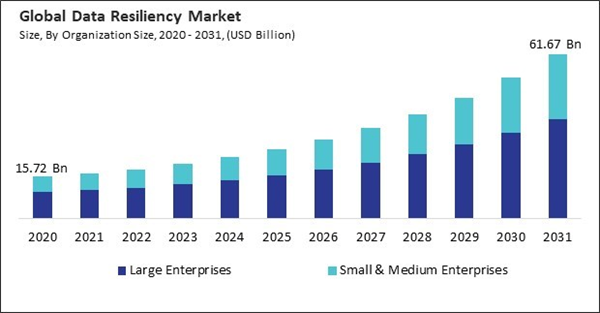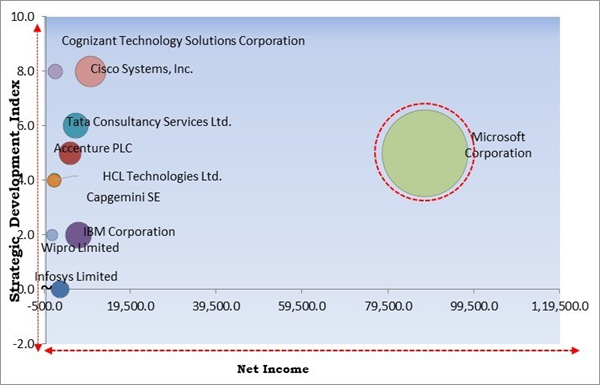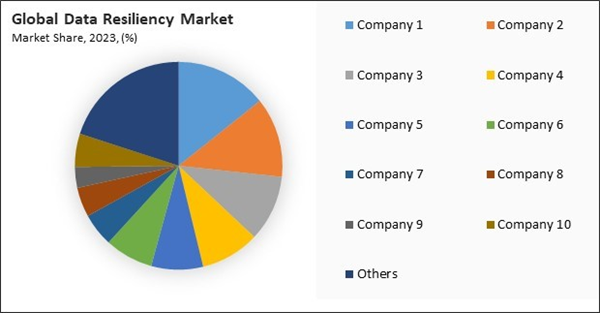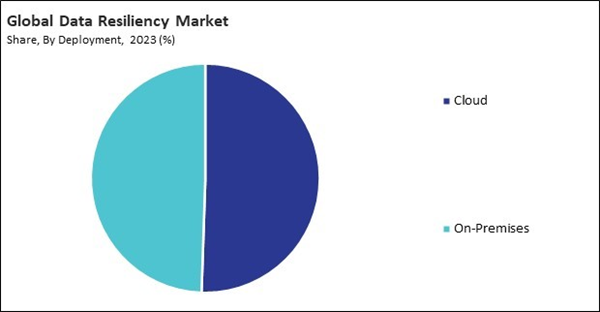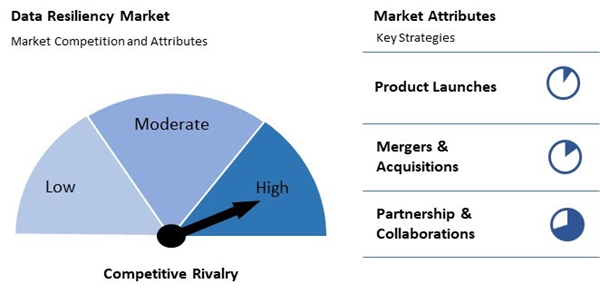The Global Data Resiliency Market size is expected to reach $61.67 billion by 2031, rising at a market growth of 15.1% CAGR during the forecast period.
The North America segment witnessed 35% revenue share in the market in 2023. Stringent data protection regulations, such as the U.S.'s California Consumer Privacy Act (CCPA) and the Personal Information Protection and Electronic Documents Act (PIPEDA) in Canada, compel organizations to prioritize data resiliency. Furthermore, the elevated incidence of cyberattacks and data intrusions within the region has compelled enterprises to allocate resources towards the implementation of comprehensive backup and disaster recovery solutions.
The major strategies followed by the market participants are Partnerships as the key developmental strategy to keep pace with the changing demands of end users. For instance, In October, 2024, Tata Consultancy Services Ltd. formed a partnership with Google Cloud to deliver two cybersecurity solutions - Managed Detection and Response and Secure Cloud Foundation. These solutions aim to enhance threat detection, response, and cloud security, helping businesses improve their data resiliency and cyber resilience. Moreover, In December, 2024, HCLTech and Perpetuuiti have partnered to offer a fully automated enterprise data protection and recovery solution. Combining HCLTech's RecoverNXT and Perpetuuiti’s Continuity Patrol 6.0, the collaboration aims to enhance operational resilience and disaster recovery for global enterprises.
Additionally, Digital transformation is revolutionizing industries worldwide as enterprises adopt advanced technologies like cloud computing, AI, IoT, and big data to enhance operations and customer experiences. Initiatives such as Industry 4.0, Smart Cities, and Digital India drive significant advancements, generating massive volumes of data requiring robust protection. Therefore, these developments will aid in the expansion of the market.
The leading players in the market are competing with diverse innovative offerings to remain competitive in the market. The above illustration shows the percentage of revenue shared by some of the leading companies in the market. The leading players of the market are adopting various strategies in order to cater demand coming from the different industries. The key developmental strategies in the market are Partnerships, Collaborations & Agreements.
The Data Resiliency Market sees heightened competition among mid-sized and emerging firms, fostering innovation in backup, disaster recovery, and security solutions. Open-source and cloud-based alternatives gain traction, while regional vendors expand aggressively. Pricing pressure, technological advancements, and compliance demands drive differentiation, making agility and strategic partnerships crucial for gaining market share.
The North America segment witnessed 35% revenue share in the market in 2023. Stringent data protection regulations, such as the U.S.'s California Consumer Privacy Act (CCPA) and the Personal Information Protection and Electronic Documents Act (PIPEDA) in Canada, compel organizations to prioritize data resiliency. Furthermore, the elevated incidence of cyberattacks and data intrusions within the region has compelled enterprises to allocate resources towards the implementation of comprehensive backup and disaster recovery solutions.
The major strategies followed by the market participants are Partnerships as the key developmental strategy to keep pace with the changing demands of end users. For instance, In October, 2024, Tata Consultancy Services Ltd. formed a partnership with Google Cloud to deliver two cybersecurity solutions - Managed Detection and Response and Secure Cloud Foundation. These solutions aim to enhance threat detection, response, and cloud security, helping businesses improve their data resiliency and cyber resilience. Moreover, In December, 2024, HCLTech and Perpetuuiti have partnered to offer a fully automated enterprise data protection and recovery solution. Combining HCLTech's RecoverNXT and Perpetuuiti’s Continuity Patrol 6.0, the collaboration aims to enhance operational resilience and disaster recovery for global enterprises.
Cardinal Matrix - Market Competition Analysis
Based on the Analysis presented in the Cardinal matrix; Microsoft Corporation is the forerunner in the Data Resiliency Market. In November, 2024, Microsoft Corporation and Kyndryl came into partnership to launch new services to enhance cyber resilience. The collaboration integrates Microsoft's security technologies with Kyndryl's expertise, offering services such as compliance readiness, threat detection, and identity management, helping businesses safeguard data and improve security operations. Companies such as Cisco Systems, Inc., Tata Consultancy Services Ltd. and IBM Corporation are some of the key innovators in Data Resiliency Market.Market Growth Factors
Technologies such as artificial intelligence (AI), machine learning (ML), and advanced analytics are pivotal in enhancing the capabilities of data protection and recovery systems. These innovations enable organizations to move beyond traditional reactive approaches and adopt proactive data management strategies. By leveraging AI and ML, these resiliency solutions can perform predictive analysis, identifying potential vulnerabilities or threats before they escalate into major issues. Hence, the adoption of emerging technologies is revolutionizing the data resiliency landscape.Additionally, Digital transformation is revolutionizing industries worldwide as enterprises adopt advanced technologies like cloud computing, AI, IoT, and big data to enhance operations and customer experiences. Initiatives such as Industry 4.0, Smart Cities, and Digital India drive significant advancements, generating massive volumes of data requiring robust protection. Therefore, these developments will aid in the expansion of the market.
Market Restraining Factors
However, In today's data-driven world, organizations face mounting challenges in ensuring data privacy and complying with various regulatory requirements. Laws like the General Data Protection Regulation (GDPR) in the European Union, the California Consumer Privacy Act (CCPA) in the United States, and the Health Insurance Portability and Accountability Act (HIPAA) in healthcare impose strict guidelines on how data should be stored, managed, and protected. Hence, these issues hamper the growth of the market.The leading players in the market are competing with diverse innovative offerings to remain competitive in the market. The above illustration shows the percentage of revenue shared by some of the leading companies in the market. The leading players of the market are adopting various strategies in order to cater demand coming from the different industries. The key developmental strategies in the market are Partnerships, Collaborations & Agreements.
Driving and Restraining Factors
Drivers
- Growing Adoption Of Emerging Technologies
- Rising Cybersecurity Threats Across The World
- Rapid Pace Of Digital Transformation
Restraints
- Data Privacy And Compliance Issues
- Complexity Of Integration With Legacy Systems
Opportunities
- Rapid Shift To Cloud Computing
- Increasing Demand For Business Continuity
Challenges
- Requirement Of High Implementation Costs
- Perception Of Low Return On Investment (ROI)
Organization Size Outlook
By organization size, the market is divided into large enterprises and small & medium enterprises. The small & medium enterprises segment witnessed 37% revenue share in the market in 2023. SMEs are adopting cost-effective data resiliency solutions, particularly cloud-based backup and disaster recovery tools, which offer scalability and affordability. The growing availability of managed services and disaster recovery-as-a-service (DRaaS) further enables SMEs to implement comprehensive data protection strategies without significant upfront investments.End-use Outlook
Based on end-use, the market is segmented into BFSI, government, energy & utilities, healthcare, manufacturing, retail, IT & telecom, media & entertainment, and others. The healthcare segment procured 12% revenue share in the market in 2023. These technologies generate vast amounts of critical patient data that must remain secure and accessible to ensure high-quality care and regulatory compliance. Laws like HIPAA in the U.S. and GDPR in Europe mandate the secure handling of patient information, requiring healthcare providers to implement robust data protection mechanisms.Deployment Outlook
Based on deployment, the market is bifurcated into on-premises and cloud. The on-premises segment garnered 49% revenue share in the market in 2023. The on-premise segment is driven by organizations’ need for complete control over their data and infrastructure, particularly in industries with stringent regulatory and compliance requirements, such as healthcare, finance, and government. These sectors prioritize on-premise solutions to ensure data security, meet legal mandates, and maintain operational sovereignty.Type outlook
On the basis of type, the market is classified into solution and services. The services segment recorded 36% revenue share in the market in 2023. The services segment is propelled by the need for specialized expertise in deploying and managing these resiliency solutions. Organizations often seek consulting services to assess their unique requirements, implement customized solutions, and ensure seamless integration with existing IT infrastructure. The complexity of hybrid and multi-cloud environments has increased the demand for managed services to monitor, maintain, and optimize resiliency systems.Market Competition and Attributes
The Data Resiliency Market sees heightened competition among mid-sized and emerging firms, fostering innovation in backup, disaster recovery, and security solutions. Open-source and cloud-based alternatives gain traction, while regional vendors expand aggressively. Pricing pressure, technological advancements, and compliance demands drive differentiation, making agility and strategic partnerships crucial for gaining market share.
By Regional Analysis
Region-wise, the market is analyzed across North America, Europe, Asia Pacific, and LAMEA. The Asia Pacific segment garnered 28% revenue share in the market in 2023. The increasing number of small and medium-sized enterprises (SMEs) in countries like China, India, and Southeast Asia has created a strong demand for cost-effective and scalable solutions. The increasing recognition of cybersecurity threats, coupled with the implementation of data protection regulations within the region, has significantly enhanced investments in disaster recovery and backup solutions.Recent Strategies Deployed in the Market
- Dec-2024: Tata Consultancy Services (TCS) expanded its cybersecurity offerings with the launch of its 2025 Cybersecurity Outlook, highlighting the integration of generative AI, cloud security, and enhanced cyber resilience. The expansion includes solutions for strengthening supply chain resilience and adopting zero-trust security frameworks.
- Dec-2024: Wipro Limited has partnered with Netskope to enhance cybersecurity outcomes for global enterprises. Their joint CyberTransformSM Optimization Service offers tailored SASE solutions, optimizing infrastructure, reducing costs, and improving performance to help clients achieve better business results and data resilience.
- Dec-2024: Cognizant Technology Solutions Corporation partners with Beyond Bank Australia to enhance digital transformation, focusing on IT infrastructure modernization, operational resilience, and data management strategies. The collaboration aims to improve security, scalability, and customer experience, with a focus on data resiliency and innovation.
- Oct-2024: Cognizant partners with Alnylam Pharmaceuticals to manage global IT operations, cloud, security, and advanced data analytics. The collaboration aims to improve automation, reduce operational efforts, and enhance transparency, helping Alnylam accelerate its business and deliver transformative medicines.
- Nov-2024: Cisco has completed the acquisition of Splunk, combining their strengths to offer advanced security, observability, and data resilience solutions. This partnership aims to provide organizations with enhanced visibility, protection, and AI capabilities, supporting digital transformation and resilience across industries.
List of Key Companies Profiled
- IBM Corporation
- Accenture PLC
- Infosys Limited
- Tata Consultancy Services Ltd.
- Wipro Limited
- Capgemini SE
- Cognizant Technology Solutions Corporation
- Cisco Systems, Inc.
- HCL Technologies Ltd.
- Microsoft Corporation
Market Report Segmentation
By Organization Size
- Large Enterprises
- Small & Medium Enterprises
By End-use
- BFSI
- Government
- Energy & Utilities
- Healthcare
- Manufacturing
- Retail
- Telecom & IT
- Media & Entertainment
- Other End-use
By Deployment
- Cloud
- On-Premises
By Type
- Solution
- Data Backup & Recovery
- Data Archiving & E-Discovery
- Disaster Recovery
- Services
- Professional Service
- Managed Service
By Geography
- North America
- US
- Canada
- Mexico
- Rest of North America
- Europe
- Germany
- UK
- France
- Russia
- Spain
- Italy
- Rest of Europe
- Asia Pacific
- China
- Japan
- India
- South Korea
- Singapore
- Malaysia
- Rest of Asia Pacific
- LAMEA
- Brazil
- Argentina
- UAE
- Saudi Arabia
- South Africa
- Nigeria
- Rest of LAMEA
Table of Contents
Chapter 1. Market Scope & Methodology
Chapter 2. Market at a Glance
Chapter 3. Market Overview
Chapter 4. Competition Analysis - Global
Chapter 5. Global Data Resiliency Market by Organization Size
Chapter 6. Global Data Resiliency Market by End-use
Chapter 7. Global Data Resiliency Market by Deployment
Chapter 8. Global Data Resiliency Market by Type
Chapter 9. Global Data Resiliency Market by Region
Chapter 10. Company Profiles
Companies Mentioned
- IBM Corporation
- Accenture PLC
- Infosys Limited
- Tata Consultancy Services Ltd.
- Wipro Limited
- Capgemini SE
- Cognizant Technology Solutions Corporation
- Cisco Systems, Inc.
- HCL Technologies Ltd.
- Microsoft Corporation
Methodology

LOADING...



